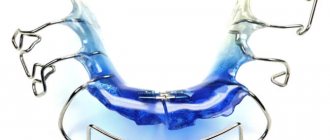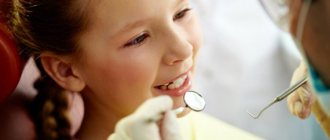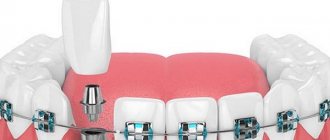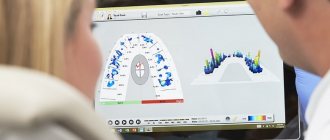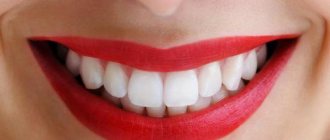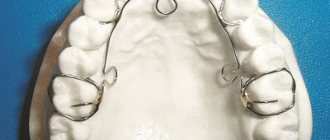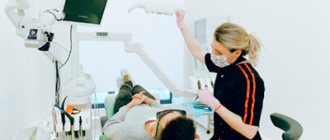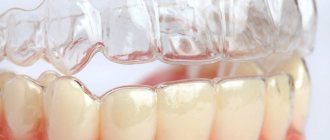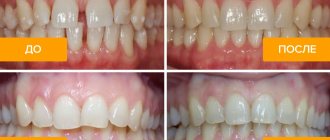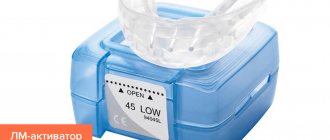Deviations in the development of occlusion, as a rule, are detected in patients of a younger age group - and already during this period it is possible to carry out therapeutic measures aimed at eliminating a specific anomaly. The Andresen-Goipl activator is prescribed in situations where correction of a mixed or permanent bite is required, and is a removable structure that is fixed on the upper and lower rows and forms a single active block that affects the jaw region. The device is created taking into account the individual anatomical features of the structure of the oral cavity, and is allowed for installation starting from the second stage of the formation of the primary occlusion, helping to eliminate cross and mixed occlusion by changing the relative position of the elements.
Design features of the Andresen-Goipl activator
This orthodontic product is a closed monoblock. The activator consists of the following elements:
- plastic base for the upper and lower jaw;
- Coffin springs, manufactured using medical wire 1.2 - 1.5 mm in diameter;
- vestibular arch - made of wire 0.6 - 0.8 mm in diameter;
- a large number of guide planes;
- activating loops, clasps, screw.
The Andresen-Goipl activator is made according to individual patient models obtained on the basis of casts reflecting the expected bite after correction.
Activator manufacturing process
Preparing the system includes several stages. At the preliminary stage, a plaster cast is formed, which is the basis for creating a model of the jaw. Based on the obtained sample, the doctor marks the boundary of the base, and also indicates the placement points of auxiliary structures and the cutting trajectory.
During the manufacturing process, specific factors are taken into account:
- the front border of the apparatus should lie along the cutting surfaces of the top row;
- the posterior border is determined by the line of closure of the lateral units;
- the lower part should cover the sublingual area.
The design is modeled based on the characteristics of the jaw structure. The space between the surfaces is filled with a wax mass, after which bite ridges are installed, combined with the upper model. The finished device is filled with plastic, polished and ground. The bases are sawed in accordance with the originally intended line, after which the functional operation of the system is checked.
Operating principle of the Andresen-Goipl activator
The ability to fix the lower jaw in the required (extended) position gives impetus to its development. In this regard, the growth of the upper jaw is inhibited, the bite becomes disconnected, and the work of the facial and masticatory muscles returns to normal.
Placing an inclined plane along the entire dentition makes it possible to move teeth in three planes - to the side, back and forward. This makes it possible, with some design changes and additions to the activator, to successfully use it to correct not only distal occlusion, but also other deviations of occlusion.
Treatment prices
The cost of correcting an open bite directly depends on the complexity of the defect. The total cost includes inspection and consultation with a specialist, payment for the procedure for installing a correction device, as well as the purchase of the structure itself. If surgical intervention is required for bite therapy, the price will be higher.
It is better to find out more about how much such bite treatment will cost directly in the clinic.
The iOrtho clinic network provides high-quality services for correcting malocclusion with Invisalign aligners, sign up for a consultation now!
Indications and contraindications
The use of a monoblock is advisable in correcting the following dental defects:
- Distal bite - to treat this pathology, the guide planes must fit tightly to the mesial surface of the dental crowns in the upper jaw and to the distal surface of the teeth in the lower jaw. The vestibular arch is located on the upper incisors, and the Coffin spring is located in the center of the palatal suture. This position of the activator provokes movement of the lower jaw in the mesial direction. In order to prevent the external (vestibular) inclination of the dental crowns of the lower incisors, when they are in a vertical position, an additional plastic side is made that overlaps the teeth by a third.
- Mesial bite - an activator with an expansion screw and a vestibular arch on the lower jaw is used. This stops the growth of the anterior part of the lower jaw, which helps eliminate the pathology.
- Open bite - when the alveolar process is lengthened in the lateral sections of the dentition, the guide planes are removed in the area of non-occlusion of the teeth - the anterior section. At the same time, they are left in the lateral ones, which leads to “hammering” of the lateral dental crowns and lengthening of the front part of the dentition.
- Deep bite - separation of the bite when filing planes on the side of the premolar and molars leads to the growth and elongation of the alveolar processes of the lateral section. The inclusion of expansion elements in a product involves removing part of the plate to release them.
The Andresen-Goipl activator has a small number of contraindications.
The device cannot be used if the patient has the following pathologies:
- dysfunction of breathing through the nose;
- allergy to materials used in the manufacture of the structure.
Varieties
Since correcting a bite in childhood is not a very difficult task, doctors strongly recommend not delaying a visit to an orthodontist. Until the situation reaches a critical point, a plate can help correct the position of the dentition. Today there are several types of them.
Fixed
Their main purpose is to straighten the teeth from the outside in the shortest possible time. The entire system is a structure consisting of small locks into which strong power arcs made of metal are inserted. It is only necessary to occasionally adjust the tension of the arc, and the result will not be long in coming.
Main advantages:
- Such records are practically invisible to others when communicating.
- Caring for them is very easy and simple, it does not take much time.
- Installing the plates is not painful; anesthesia and anesthesia are not required.
- Efficiency and fairly short term of bite correction.
- Hypoallergenic and safe all materials used.
- Parents do not need to constantly monitor their child’s wearing of the plate, because he cannot remove it.
Like any treatment method, bite correction using plates has several disadvantages:
- They are practically powerless in case of severe deformations and in the presence of individual characteristics of the body.
- Since the system blocks the taste buds, the child may complain of a lack of perception of different tastes.
- Diction may deteriorate and a lisp may appear.
- It takes time to adapt.
Removable
Such orthodontic structures are made strictly according to the individual parameters of the jaw of each individual child. Only a professional doctor can decide which units of the row to attach the fixing elements to.
Removable plates can only help cope with minor bite pathologies and the presence of small gaps.
Positive and negative aspects of the Andresen-Goipl activator
The advantages of this orthodontic product include:
- Treatment with the device takes place at night;
- there are no problems with hygienic care of the product - after use, the orthodontic product is cleaned with a toothbrush and paste, washed under running warm water, dried and stored in a special container;
- there is no need for frequent visits to the dental office;
- the universality of the activator action - eliminates the pathology of occlusion, promotes the correct position of the tongue in the oral cavity and normalizes the functioning of the facial muscles.
The disadvantages inherent in the Andresen-Goipl activator are:
- the need for strict control by parents over the schedule for wearing the product - the result of treatment depends on this;
- the inability to communicate during treatment makes nighttime use of the device preferable.
Advantages and disadvantages
The cost of producing a monoblock and the duration of treatment make parents doubt the proposed solution to the problem. When weighing all the features of the device, one should take into account not only the speed and effectiveness of such correction, but also possible discomfort and complications for the child. The device has a lot of positive qualities:
- The activator can be removed and put on independently, which simplifies the process of brushing teeth and eating. In addition, the child will not feel embarrassed because of a foreign object in the mouth, which prevents him from communicating with peers throughout the day.
- The product is easy to clean, so the child can wash the device independently at a convenient time.
- Simple operating rules.
Despite the fact that the activator has obvious positive characteristics, it should be noted that this type of treatment also has its disadvantages:
- Due to the fact that the device can be removed at any time, the child may not follow the operating instructions. If the product is not worn for the prescribed number of hours, the treatment results may not be noticeable.
- The device must not be used if breathing through the nose is impaired, as it completely blocks the ability to breathe through the mouth. Therefore, before starting the course, you should undergo an examination by an otolaryngologist.
Negative aspects can be avoided if parents take control of the entire process of correcting the bite and monitor compliance with the doctor’s instructions.
Frenkel function apparatus
It consists of two buccal shields and two lip pads made of plastic, interconnected by a metal frame - a palatal clasp, lingual and vestibular arches and other parts.
It is used in primary, mixed and permanent dentition for the treatment of anomalies in the position of the anterior teeth, distal deep bite with protrusion of the anterior teeth /type 1/, for the treatment of distal deep bite combined with retrusion of the upper anterior teeth /type 2/, for the treatment of mesial occlusion / type Z/, for the treatment of open bite /type 4/.
The object of the device's influence is the muscles, the training of which helps to normalize functions. Closing of the lips is achieved - normalization of breathing function and tongue position. The pressure around and intraoral muscles is transmitted to the dentition and alveolar process of the jaws, helping to correct the bite in the sagittal, vertical and transverse directions.
Author of the article: Elena Yurievna Krivopusk, orthodontist
Dear Colleagues! When copying information, placing a link to the source site is mandatory!
Duration of treatment
The duration of wearing an orthodontic appliance will be different for each patient. The severity and severity of the pathology, which is supposed to be solved with the help of a specific device, plays a very direct role here. The individual characteristics of the patient also play a role, so at the initial stage even a certified doctor can only give an approximate treatment time. During the wearing process, when the first results become noticeable, it will be possible to make assumptions about the time of removal of the device.
The duration of correction is individual for each child. The full course of treatment can start from several months and end in 2-3 years. On average, the most common period is approximately 1.5 years. During the treatment process, the plates and some of their elements may be replaced depending on the results obtained and the necessary adjustments.
The device is usually worn only at night, since it is impossible to talk with it and breathe through the mouth. Therefore, the duration of treatment often turns out to be longer than originally planned. Before treatment, it is imperative to show the child to a therapist and otolaryngologist. If you have problems with nasal breathing, wearing this device is strictly contraindicated .
General introduction and purpose of application
Bionators are myofunctional devices with combined effects. The purpose of their use in orthodontics is to eliminate functional or morphological disorders of the dental system during periods of primary or permanent dentition.
The devices can rearrange the position and inclination of the teeth, expand/contract the jaws and rows of teeth, and eliminate the incorrect relationship of the jaws relative to each other. Bionators work well with facial muscles and jaw ligaments.
Successful correction of malocclusions using devices is ensured by:
- reliable fastening and stable support;
- sufficient strength to move and turn teeth;
- the absence of an obstacle in the way of displaced units, and the availability of space in a row.
Advantages of contacting the First Family Clinic
- Preparation of an individual bite correction program for each patient.
- Selecting a model of removable braces that suits the situation.
- Treatment is supervised by highly qualified experienced specialists.
- Carrying out computer diagnostics of the condition of the dentofacial apparatus for the most accurate assessment of the clinical case and selection of optimal treatment tactics.
- Regular promotions and discounts that make prices for our services even more affordable.
Our orthodontists are seen in the Primorsky district at 36/2 Kolomyazhsky Ave. (metro stations “Pionerskaya”, “Udelnaya”) and st. Gakkelevskaya, 20, building 1 (metro station "Staraya Derevnya", "Komendantsky Prospekt"), and in the Petrogradsky district - Kamennoostrovskaya Ave. 16 (metro station "Petrogradskaya", "Gorkovskaya", " Chkalovskaya").
Bruckle apparatus
It consists of a plate base for the lower jaw with a retraction arch and an inclined plane in the area of the anterior teeth. It is a combined action device, removable. It is used in primary and mixed dentition with mesial occlusion. This appliance uses the springing properties of a retraction arch to lingually move the anterior teeth of the lower jaw and the contractility of the masticatory muscles, which allows the anterior teeth of the upper jaw to be moved vestibularly using an inclined plane.
Single jaw plates
They consist of a plate base with one or more orthodontic screws. This is a mechanical device, removable. It is used in primary, mixed and permanent dentition with uniformly and unevenly narrowed dentition, shortened dentition, and abnormal position of individual teeth. The principle of operation is to use the pressure that occurs when unwinding or tightening the screw spindle to uniformly or unevenly expand the dentition, move individual teeth and groups of teeth.
